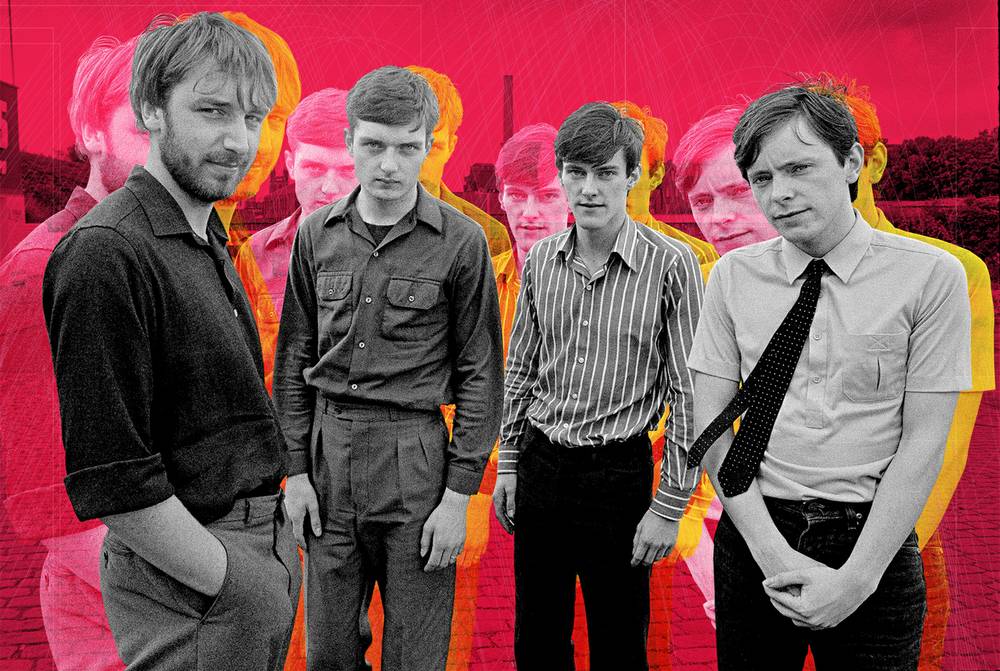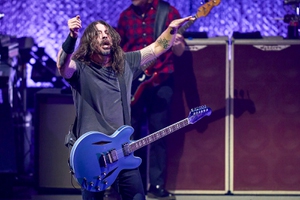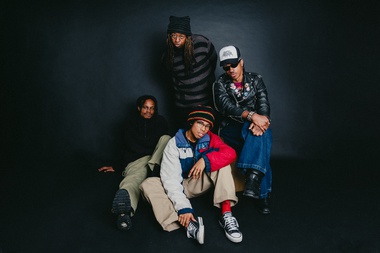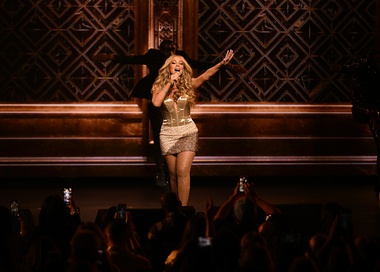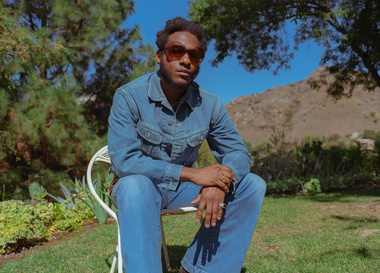Modern dance-punks Moving Units are gearing up for a short tour paying homage to post-punk legends Joy Division—a trek that follows the release of July album Collision With Joy Division, which features faithful covers of the British band’s legendary songs. Moving Units frontman Blake Miller detailed how the ambitious project came about, and what he’s learned tackling some of the most influential music of all time.
How did the idea for the Joy Division project come about? Jeff [Shuman], a talent buyer in Orange County, approached our agent with the idea. At first, I was a little intimidated by the offer, I’m not gonna lie. I know Joy Division fans, [and] those are some big shoes to try to fill, [so] I wasn’t totally sure I wanted to go there. After I lived with it, I realized I’m just another Joy Division fan who’s getting the opportunity to enjoy playing all these songs that I loved and listened to all my life. All of a sudden, it changed in my head from being an intimidating concept to something really celebratory.
How did you choose which songs to play? At first, I considered doing an album. But then I realized there are so many good tracks that I didn’t really want to be stuck in that box. I spent some time combing through their releases and their B-sides as well as the hits and album tracks.
One thing that’s special about us is we always bring a lot of raw energy to our shows. I feel like that’s something our crowds have come to expect, and that’s something we always pride ourselves on channeling—that spontaneous, contagious excitement of losing yourself in the crowd and losing yourself in the moment and dancing and having a great moment of transcendence in the space of people that are around you, as well as the musicians on the stage. I used that as my guide for choosing songs. I wanted to build a set that felt super-essential and where the energy was undeniable from start to finish. I felt like the best way to pay tribute to the band was to showcase the material I felt like had the most electrifying influence when you see these things live.
I decided to take a pretty faithful approach to reproducing the material, because all of their parts were so well-written. The basslines are super-catchy but really weird and angular, and the drums are so repetitive and machine-like. When we got deeper into the rehearsal process as well as production—we finished producing an entire album of all the songs that we’re performing live—it was such an immersive experience. I had to get to know that material so well—[to] strip it down and get into the seams, the fabric of those recordings as well as the compositions was such an inspiring experience.
As you were digging into the music, did anything about it surprise or stand out to you? Totally. There are so many weird left turns that you can discover when you’re analyzing it on that level. It just made me appreciate it all the more. There’s some really bizarre turns of phrase that Ian [Curtis] used.
For one example, from “Interzone,” [there’s] a call-and-response vocal: He’s answering his own vocal, so it’s set up so the first line hits and the answer steps on top of the lead vocal. It’s clumsy and oddly worded when you print the lyrics out and start breaking them down. But there’s some strange beauty about how awkward and fearless his lyrics are.
I felt like I was seeing through a different lens when I was reading his lyrics and trying to interpret them. When you’re just bumping it on your sound system, you don’t necessarily listen to it the same way. Some of those nuances I’d never noticed before. I appreciated how dedicated he was to his vision—he wasn’t going to polish some of the weird edges. Even though a lyric might come off as slightly off-putting, he owned it. And when he got on the mic, it all sounded right.
When we were just jamming the songs, trying to memorize the arrangements was a constant challenge. I get the feeling a lot of those tunes were written spontaneously in the studio, and I’m not sure if they really mapped out their arrangements as carefully in their rehearsal studio as a band like mine has or a lot of other bands typically do. There’s a certain sense of, like, this song sounds like it’s going to fall apart at any given moment (laughs), because people are doing things [in] weird places. There’s not a whole lot of repetition in their patterns. The music itself has a repetitive quality, but when you break it down you realize, “Oh, that guitar part doesn’t necessarily repeat the same way.” It’s always a little different, or the cue for when a guitar part might key off a vocal is totally counterintuitive.
We decided to learn those, warts and all, because for us that’s what makes that band so special—they weren’t using any kind of pop formula or any really success-driven strategy. These guys were in the moment. They were inspired to make that music happen, and it came out exactly the way it should. It was fun to discover that on a different macro level.
As a musician, that’s an interesting challenge, to dig into and analyze all this stuff. As a fan, too, you listen to Joy Division, and it’s almost too easy to take them for granted, because there are so many bands that cite them as an influence. To dive into it on a granular level and rediscover their genius must be a fun exercise. I can’t say enough good things about how inspiring this experience has been for me as a fan and as a writer and a musician. It’s given me a chance, as a human being and a musician, to experience their music on a level I never would’ve really had a reason to explore.
There’s something austere and almost unnerving about some of their music and lyrical themes, but I feel like there’s also a sense of jubilance. There’s genuine joy in those tracks that really shines through. That’s an essence we wanted to bring to the surface when we produced the recordings and when we bring this material to the stage. It’s a celebration of the work they did together in a band called Joy Division, and it’s also a celebration of being alive now and celebrating music with people who are enjoying what music does to uplift us and make our lives more meaningful and beautiful.
When I listen to certain Joy Division songs, they sound like a sunrise to me. There’s a buoyancy to it. People who think the band is just depressing miss the point. There’s a lot of nuance to Joy Division. That’s a really cool metaphor. A sunrise does illustrate that sense of hopefulness. There’s something bleak about it, but it’s also got that glimmer of hope and excitement and that sense of looking at the horizon feeling like there’s something bigger, something more illuminating about to transpire.
I think they did that sonically as well. They were completely innovating with their sonic choices and the way they blended guitar, bass and drums, which is essentially a primitive rock ’n’ roll trio of instrumentation at this point. They were throwing out all the rules and bending them in the coolest way.
We’re fortunate enough to be working with a buddy of ours named Dave Trumfio, who’s a pretty well-known music producer and musician in his own right. He has a passion for this era and that band as well, and he was also able to bring all these amazing vintage instruments and gear to the table, so we were able to use the same analog string machine or synths that they used to produce their recordings. There’s something exciting about knowing we were able to reproduce some of those parts using the same gear, same instrumentation. I liked the challenge of finding ways to reproduce accents and highlights of their music sonically, but still it’s modern production and value and sensibility. That was fun to have a chance to give it a little bit of a 2016 flavor without having to completely reinterpret the band or reinterpret the songs.
There’s one song in particular I decided to take a little bit of liberty with, and that’s “Insight” from Unknown Pleasures. I love that song so much. I decided to do a couple little things, and all of a sudden it became this really cool, alternate version that turned the beat into more of a menacing disco beat, and I rewrote a bassline that’s more in the style of our band a little bit—more disco-punk or kind of funky. The vocals stayed exactly the same; I just loved the way the composite turned out. It’s probably the song that will bear the least resemblance to the original, but I feel like it’s the one song I was able to justify changing a few key components [in], because the end results are so cool.
Factory Records was so on fire during that era. Almost every release they put out between ’79 and ’81 I would consider essential listening. So many bands were tapping into that interesting aesthetic. There’s something really tense and elastic about that sound, but there’s a lot of diversity in some of those Factory releases that I really enjoy immersing myself in. A band like Section 25, for instance, [is] lesser-known than Joy Division, but they were doing something sort of similar, in the sense that it was a mutated version of disco, but with all this dark, affected production and anxious vocals that I really love. There’s a sexual energy there that’s very interesting, but it’s not presented in a typical context. It’s kind of uncomfortable and anxious and awkward and unsure of itself. I really identify with those kind of emotions. (laughs)
How do you think your Joy Division project might influence future music you’re going to make? Have you found yourself using anything you’ve gleaned? That’s kind of how I work anyway—I’m very impulsive when it comes to my creative process. I noticed that within even a week or so of really investing time in the material and starting to learn the parts [and] study the vocal phrasing.
It’s like the feeling of if you’ve been training to run a marathon. I imagine you might get lost in that training experience at some point when you’re not really necessarily conscious of the way it’s changing your body or the way it’s changing your biorhythms, but all of a sudden one day it’s time to race and you just feel this strength and agility that almost seems foreign to you. I think of it that way when it comes to flexing my creative impulses. It felt like I had almost like a new vocabulary. I really attribute that to the influence of these songs. They were able to open new windows in my mind, so approaching a bass riff or a guitar part or a vocal phrasing, suddenly I felt like I had more options.
When I boil it all down, it’s probably a confidence thing. I felt more confident about exploring things that were in my wheelhouse. It was an amazing feeling, to go through Joy Division bootcamp. I totally expect that to have a huge influence on the next album we write and produce, as well as the state of mind that I take with me to productions with other artists. I’m always looking for new ways to bring a different perspective or some new creative techniques into the process. I feel supercharged after the time we’ve been spending working with this material. It’s exciting.
Moving Units presents the Songs of Joy Division with Viktor Fiction, DJ Hector Rawkerz. August 6, 9 p.m., $10-$12. Bunkhouse Saloon, 702-982-1764.
